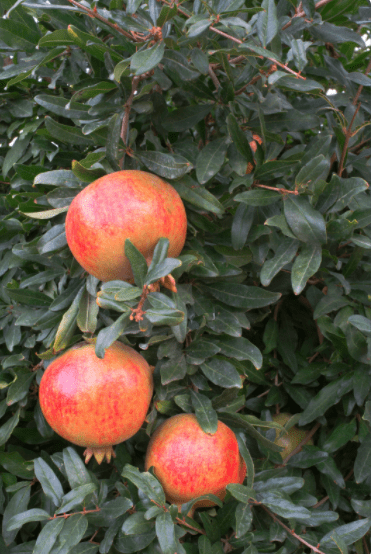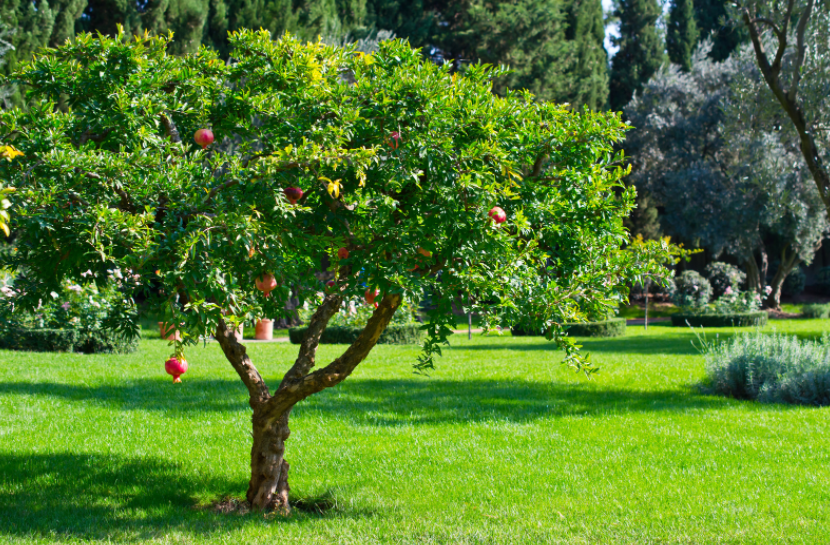Pomegranate Tree
Pomegranate Tree, Punica Granatum, also known by the name pomegranate. The Punica granatum is part of the Punicaceae family. This little semi-deciduous plant is steeped in romance and history.
The pomegranate fruit is a fleshy and scarlet berry, and the tree was planted during the Bronze Age in Iran towards the Himalayas located in north India.
Since the beginning of time, the pomegranate fruit has been grown and naturally cultivated throughout Asia and the Mediterranean area in Asia, Africa, and Europe.
It has held a place that was important alongside both the fig and grape. Many considered it to be the apple of the garden of Eden.
The pomegranate was the subject of Egyptian artwork and mythology. It was praised by the Old Testament in the Bible and the Talmud and was transported by caravans of the desert to enjoy its refreshing juice.
The Romans first came across pomegranates in large groves of the Phoenician colony of Carthage or Punica, which is Punica is the Roman term for Carthage during the Punic Wars (264 to 146 BCE).
Pliny the Elder called “the tree “malum punicum, the Carthaginian apple.” According to Latin, “pomum granatum” was “apple of many seeds.”
Therefore, the Punic Wars brought elephants to the Alps and the Punica, the pomegranate or granatum, to Rome. Many centuries after, Spanish sailors brought pomegranates along on their exploration cruises and brought them into new lands in the New World.
Pomegranate Tree In U.S
Pomegranates came to California in 1769, accompanied by Spanish missionaries. The cultivar “WonderfulO, One of the most well-known cultivars in Redlands, was propagated in California in 1896.
The pomegranate is a beautiful small roundish tree that is multi-branched and covered in shiny green lance-shaped leaves. Unique fleshy-skinned fruits follow the stunning, self-pollinating orange-red flowering plants in the autumn.
The tree is thriving in a variety of soils, including alkaline. It is a fan of our scorching heat and sun. It is drought-resistant, once established. It is virtually free of the majority of bugs and diseases.

Many cultivars are ornamental and fruiting. The standard size can expand to around 15 or 25 feet, while the dwarf can grow to 3-8 feet. Both are excellent landscape plants. The pomegranate can last for a very long time.
There are specimens from Europe which are believed to be more than 200 years old.
The pomegranate fruit is ripe when they’ve developed a distinct color and emit an ethereal sound when they are tapped. The fruit should be picked before reaching maturity, which is likely to break open.
The fruit should not be removed but cut close to the bottom.
The pomegranate is similar to the apple in terms of extended shelf life. The fruit improves in storage, becoming more juicier and more delicious. They can be stored for up to seven months.
Over the centuries, the pomegranates were raw or converted into juices utilized in the wine, beverages syrups, jellies, and drinks.
Grenadine is made out of pomegranate juice. The fruit also has a long-standing tradition of medicinal use.
It is used for a myriad of medical reasons. It has been proven helpful in various treatments, including treating urinary problems and reducing blood pressure. The honey-based juice of the fruit is a traditional remedy to treat memory loss.
The entire tree has been utilized to produce tannins to cure leather. The flowers and the rind provide dyes to dye textiles.
Chemicals like insecticides and inks are derived from the bark and the leaves.
The wood is exceptionally durable and utilized for walking sticks and woodcrafts.
How to Plant Pomegranate Trees
When planting, make sure the soil is relaxed and not overly wet. The distribution will rest on how you propose to operate your pomegranate tree. Some growers use them as a spreading shrub hedge, and they can be spaced around 6 to 9 feet apart.
It is suitable for those employed for fruit production to distance them roughly 15 feet apart.
How To Maintain Pomegranate Tree
Light
Pomegranate trees may be raised in part shade but correctly located where high sun and warmth are available. For an excellent yield, your tree should receive at least six hours of maximum sun per day.
Ground
The pomegranate requires well-drained soil, yet it can flourish in many soils, from the acid ground (preferred) to low-quality alkaline types.
Water
The pomegranate tree is drought forgiving, yet irrigation is desired for appropriate fruit production. Water thoroughly every two to four weeks during the dry period when starting new trees.
Be attentive, however, not to over-water. Surplus water and waterlogged conditions can bring to a bad harvest. Likewise, the fruit will be highly susceptible to crack, strengthening the chances of complications with bugs and fungal contaminations.
Temperature and Humidity
The excellent growing zones for this fruit are USDA Plant Hardiness Zones 7 to 10. They like chilly winters and warm, dry summers. They prosper when growing season temperatures are above 85 degrees Fahrenheit.
Pomegranate trees are colder lenient than citrus trees, but the grades differ, revolving around the cultivar. Some can survive with winter temperatures as rough as 10 degrees Fahrenheit. However, when they sink this low, it would be reasonable to grow them in pots to bring them into a garage or alternative protected area to decrease the chance of frost deterioration.
Fertilizer
Fertilize in November and March for the initial two years. Otherwise, not many fertilizers usually are required in the following years. Over-fertilization can create a miserable harvest.
Pomegranate Tree Varieties
There are many cultivars to accept from, having more cold tolerance. Some of the favored types comprise:
- ‘Nana’: A midget form that is excellent hardy to zone seven and commonly develops to just 4 feet tall
- ‘Sweet’: Yields fruit sooner than some cultivars and, as the name points, has a delightful aroma and regularly yields a rich harvest
- ‘Wonderful’: The highly prominent cultivar grown in the U.S.; gives enormous, delicious, red fruits in wealth late in the season.
Reaping
A pomegranate tree usually requires three years to develop an appropriate harvest. You’ll see the fruits are ready to be plucked when the color has established. They have a matte sooner than bright glaze; they shift from a round to a different hexagonal shape, producing a metallic tone when tapped. Employ a pair of snipping shears to cut the stem above the fruit instead of removing it. We can keep them for a long time if stored between 32 and 40 degrees Fahrenheit.
Pruning
Pomegranates are inclined to form suckers, so take them out as they show up. If you elect not to prune your pomegranate tree, it will generate a broader, expanding, leafy, shrub-like form. Routine pruning of branches in the original few years will promote vigorous new shoot evolution and an exceptionally bountiful harvest.
Once the tree is established, it may be sufficient to prune away any deceased, broken, or rotten branches. Trim out the fruits developing on the branches. This will secure the pomegranates can advance to total volume and reduce the chance of a limb breaking because of excess load.
Propagating Pomegranate Trees
Reproduction is correctly managed through hardwood cuttings taken during the winter, as those grown from seeds may not remain faithful to type.
Familiar Pests and Disorders
Pomegranate trees are more straightforward fruits to work with since many pests or diseases do not commonly influence them.
Possible occasional pests comprise pomegranate butterflies, thrips, scale, mealybugs, and whiteflies. Infections are unusual in well-maintained trees but consist of leaf spot, fruit spot, twig dieback, dry rot, and soft rot.
























Comments are closed.